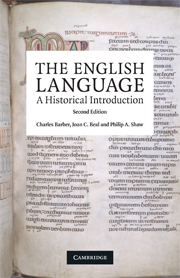Book contents
- Frontmatter
- Contents
- List of figures
- Preface to the second edition
- Preface to the first edition
- Map showing the counties of England
- 1 What is language?
- 2 The flux of language
- 3 The Indo-European languages
- 4 The Germanic languages
- 5 Old English
- 6 Norsemen and Normans
- 7 Middle English
- 8 Early Modern English
- 9 Late Modern English
- 10 English as a world language
- 11 English today and tomorrow
- Notes and suggestions for further reading
- Bibliography
- Index
5 - Old English
- Frontmatter
- Contents
- List of figures
- Preface to the second edition
- Preface to the first edition
- Map showing the counties of England
- 1 What is language?
- 2 The flux of language
- 3 The Indo-European languages
- 4 The Germanic languages
- 5 Old English
- 6 Norsemen and Normans
- 7 Middle English
- 8 Early Modern English
- 9 Late Modern English
- 10 English as a world language
- 11 English today and tomorrow
- Notes and suggestions for further reading
- Bibliography
- Index
Summary
During the three or four centuries after Tacitus wrote his Germania, the Germanic peoples were in a state of flux and movement. We know little of their history in this turbulent period of migration and expansion, but we do know that, towards the end of these centuries of flux, Germanic-speaking groups settled in England. There is some archaeological evidence that Saxons settled in East Anglia and the Vale of York while Britain was still a Roman province, but the main settlements were made after the Roman legions had withdrawn from Britain in AD 410, and the traditional accounts of the landing of Hengest and Horsa in Kent place it in the year 449.
The Anglo-Saxon settlement of Britain must not be thought of as the arrival of a unified invading army, but rather as the arrival and penetration of various uncoordinated bands in different parts of the country, beginning in the middle of the fifth century and going on all through the sixth. The processes of struggle and assimilation with Celtic-speaking Britons were lengthy, and Anglo-Saxon domination in England was not assured until late in the sixth century. We know little about these developments: it was the age of King Arthur, and there are more legends than hard facts. But by about 700, the Anglo-Saxons had occupied most of England (the exceptions being Cornwall and an area in the north-west) and also a considerable part of southern Scotland. Wales remained a British stronghold.
- Type
- Chapter
- Information
- The English LanguageA Historical Introduction, pp. 105 - 136Publisher: Cambridge University PressPrint publication year: 2009

